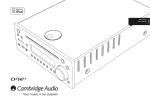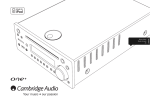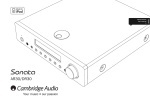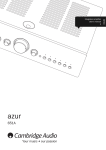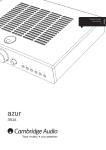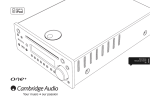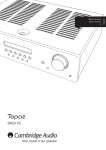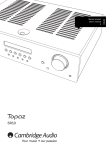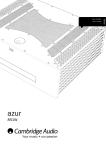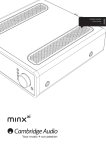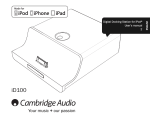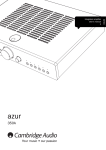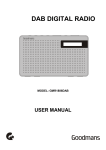Download Cambridge One
Transcript
Your music + our passion ENGLISH Micro Stereo User’s manual 2 Contents Introduction.............................................................................................................3 Important safety instructions.................................................................................4 Limited warranty .....................................................................................................7 Rear panel connections .........................................................................................8 Front panel controls .............................................................................................10 Remote control .....................................................................................................12 Connections..........................................................................................................15 Operating instructions..........................................................................................17 Turning on for the first time ......................................................................17 Tuning and listening to DAB/FM ...............................................................17 Setting presets in DAB or FM modes .......................................................17 Adjusting the balance, bass, treble and X–Bass ....................................18 Setting the clock........................................................................................18 Setting the alarm.......................................................................................18 Setting the sleep time...............................................................................19 Playing CD ..................................................................................................19 Playing MP3/WMA from USB, SD or CD ..................................................19 Repeat function.........................................................................................20 Random function.......................................................................................20 Program function.......................................................................................20 Using an iPod with the supplied DD30 docking station .........................21 iPod compatibility ......................................................................................21 Resetting the unit ......................................................................................21 Troubleshooting ....................................................................................................22 Technical specifications.......................................................................................23 2 Make sure you register your purchase! Visit: www.cambridgeaudio.com/sts By registering, you’ll be the first to know about: G Future product releases G Software upgrades G News, events and exclusive offers plus competitions! This guide is designed to make installing and using this product as easy as possible. Information in this document has been carefully checked for accuracy at the time of printing; however, Cambridge Audio's policy is one of continuous improvement, therefore design and specifications are subject to change without prior notice. This document contains proprietary information protected by copyright. All rights are reserved. No part of this manual may be reproduced by any mechanical, electronic or other means, in any form, without prior written permission of the manufacturer. All trademarks and registered trademarks are the property of their respective owners. “Made for iPod” means that an electronic accessory has been designed to connect specifically to iPod and has been certified by the developer to meet Apple performance standards. Apple is not responsible for the operation of this device or its compliance with safety and regulatory standards. © Copyright Cambridge Audio Ltd 2009 iTunes, iPod and the Apple logo are trademarks of Apple Inc., registered in the U.S. and other countries. ENGLISH Introduction Thank you for purchasing your Cambridge Audio One! We hope that you enjoy many years of listening pleasure from it. Like all Cambridge Audio products, One adheres to three core principles – stunning performance, ease of use and incredible value. One has been developed to offer uncompromised audiophile sound quality in a small, convenient and stylish package with everything you need from one compact unit. One comprises a high quality CD player, amplifier, DAB and FM tuner, memory card interfaces, and iPod functionality, drawing on our 40 years of experience in designing hi-fi. Compatible with SD and SDHC cards and USB memory sticks of up to 8Gb, One can play back MP3 or WMA files both from these and CD-R/-RW compact discs. A supplied DD30 iPod dock is compatible with all current iPod models such as iPod nano (1st, 2nd, 3rd and 4th generation), iPod (4th generation, photo and 5th generation), iPod classic, iPod touch (1st and 2nd generation) and iPhone (flight mode recommended) and a front panel MP3 input and two rear Auxiliary inputs mean that you can even connect other MP3 players, games consoles and other devices. The supplied Navigator remote provides simple access to all features and offers control of your iPod when connected to the supplied dock. Ultimate sound quality depends on the whole of your system, naturally we particularly recommend speakers from the Cambridge Audio Sirocco range as these have been designed for a perfect acoustic and aesthetic match. Your dealer can also supply excellent quality Cambridge Audio interconnects to ensure your system realises its full potential. Thanks for taking the time to read this manual; we do recommend you keep it for future reference. Matthew Bramble Cambridge Audio Technical Director and the One development team 3 Important safety instructions For your own safety please read the following important safety instructions carefully before attempting to connect this unit to the mains power supply. They will also enable you to get the best performance from and prolong the life of the unit: 1. Read these instructions. 2. Keep these instructions. 3. Heed all warnings. 4. Follow all instructions. 5. Do not use this apparatus near water. 6. Clean only with a dry cloth. 7. Do not block any ventilation openings. Install in accordance with the manufacturer's instructions. 8. Do not install near any heat sources such as radiators, heat registers, stoves, or other apparatus (including other amplifiers) that produce heat. 9. Do not defeat the safety purpose of the polarized or grounding-type plug. A polarized plug has two blades with one wider than the other. A grounding-type plug has two blades and a third grounding prong. The wide blade or the third prong are provided for your safety. If the provided plug does not fit into your outlet, consult an electrician for replacement of the obsolete outlet. 10. Protect the power cord from being walked on or pinched, particularly at plugs, convenience receptacles and the point where they exit from the apparatus. 11. Only use attachments/accessories specified by the manufacturer. 12. Use with only the cart, stand, tripod, bracket, or table specified by the manufacturer, or sold with the apparatus. When a cart is used, use caution when moving the cart/ apparatus combination to avoid injury from tip-over. 13. Unplug this apparatus during lightning storms or when unused for long periods of time. 4 14. Refer all servicing to qualified service personnel. Servicing is required when the apparatus has been damaged in any way, such as the power-supply cord or plug having been damaged, liquid has been spilled or objects have fallen into the apparatus, the apparatus has been exposed to rain or moisture, does not operate normally, or has been dropped.Important Note WARNING – To reduce the risk of fire or electric shock, do not expose this unit to rain or moisture. The unit is of Class 1 construction and must be connected to a mains socket outlet with a protective earthing connection. The unit must be installed in a manner that makes disconnection of the mains plug from the mains socket outlet (or appliance connector from the rear of the unit) possible. Where the mains plug is used as the disconnect device, the disconnect device shall remain readily operable. Only use the mains cord supplied with this unit. Please ensure there is ample ventilation. We recommend that you do not place the unit in an enclosed space; if you wish to place the unit on a shelf, use the top shelf to allow maximum ventilation. Do not put any objects on top of this unit. Do not situate it on a rug or other soft surface and do not obstruct any air inlets or outlet grilles. Do not cover the ventilation grilles with items such as newspapers, tablecloths, curtains, etc. This unit must not be used near water or exposed to dripping or splashing water or other liquids. No objects filled with liquid, such as vases, shall be placed on the unit. This unit has been designed to play compact discs, recordable CDs (CD-R) and re-writable CDs (CD-RW) bearing the identification logo shown here. No other discs can be used. The CD-R/CD-RW discs should contain properly recorded TOC (Table of Contents) information so that they can be played back. This unit can play only the discs recorded in the CDDA format designed for music reproduction or those containing MP3 or WMA files. Do not attempt to play a disc on this unit containing other data, such as a CD-ROM for PCs ENGLISH C-Tick mark This product meets the Australian Communications Authority’s Radio communications and EMC requirements. Ross Test Stamp The lightning flash with the arrowhead symbol within an equilateral triangle is intended to alert the user to the presence of un-insulated ‘dangerous voltage’ within the product’s enclosure that may be of sufficient magnitude to constitute a risk of electric shock to persons. FCC regulations The exclamation point within an equilateral triangle is intended to alert the user to the presence of important operating and maintenance instructions in the service literature relevant to this appliance. NOTE: THE MANUFACTURER IS NOT RESPONSIBLE FOR ANY RADIO OR TV INTERFERENCE CAUSED BY UNAUTHORIZED MODIFICATIONS TO THIS EQUIPMENT. SUCH MODIFICATIONS COULD VOID THE USER AUTHORITY TO OPERATE THE EQUIPMENT. WEEE symbol The crossed-out wheeled bin is the European Union symbol for indicating separate collection for electrical and electronic equipment. This product contains electrical and electronic equipment which should be reused, recycled or recovered and should not be disposed of with unsorted regular waste. Please return the unit or contact the authorised dealer from whom you purchased this product for more information. CE mark This product complies with European Low Voltage (2006/95/EC) and Electromagnetic Compatibility (89/336/EEC) Directives when used and installed according to this instruction manual. For continued compliance only Cambridge Audio accessories should be used with this product and servicing must be referred to qualified service personnel. This product meets Russian electronic safety approvals. This equipment has been tested and found to comply with the limits for a Class B digital device, pursuant to Part 15 of the FCC Rules. These limits are designed to provide reasonable protection against harmful interference in a residential installation. This equipment generates, uses and can radiate radio frequency energy and, if not installed and used in accordance with the instructions, may cause harmful interference to radio communications. However, there is no guarantee that interference will not occur in a particular installation. If this equipment does cause harmful interference to radio or television reception, which can be determined by turning the equipment off and on, the user is encouraged to try to correct the interference by one or more of the following measures: - Re-orient or relocate the receiving antenna. - Increase the separation between the equipment and receiver. - Connect the equipment into an outlet on a circuit different from that to which the receiver is connected. - Consult the dealer or an experienced radio/TV technician for help. 5 Important safety instructions (continued) Ventilation IMPORTANT - The unit will become hot when in use. Do not stack multiple units on top of each other. Do not place in an enclosed area such as a bookcase or in a cabinet without sufficient ventilation. Ensure that small objects do not fall through any ventilation grille. If this happens, switch off immediately, disconnect from the mains supply and contact your dealer for advice. Positioning This unit has been designed to be left in Standby mode when not in use as this will increase the life of the unit (this is true with all electronic equipment). To turn the unit off, switch off at the rear panel. If you do not intend to use this unit for a long period of time, unplug it from the mains socket. Overloading Do not overload wall outlets or extension cord as this can result in a risk of fire or electric shock. Overloaded AC outlets, extension cords, frayed power cords, damaged or cracked wire insulation, and broken plugs are dangerous. They may result in a shock or fire hazard. Choose the installation location carefully. Avoid placing it in direct sunlight or close to a source of heat. No naked flame sources, such as lighted candles, should be placed on the unit. Also avoid locations subject to vibration and excessive dust, cold or moisture. The unit can be used in a moderate climate. Be sure to insert each power cord securely. To prevent hum and noise, do not bundle the interconnect leads with the power cord or speaker leads. This unit must be installed on a sturdy, level surface. Do not place in a sealed area such as a bookcase or in a cabinet. Any space open at the back (such as a dedicated equipment rack) is fine however. Do not place the unit on an unstable surface or shelf. The unit may fall, causing serious injury to a child or adult as well as serious damage to the product. Do not place other equipment on top of the unit. To clean the unit, wipe its case with a dry, lint-free cloth. Do not use any cleaning fluids containing alcohol, ammonia or abrasives. Do not spray an aerosol at or near the unit. Due to stray magnetic fields turntables or CRT TVs should not be located nearby due to possible interference. Electronic audio components have a running in period of around a week (if used several hours per day). This will allow the new components to settle down, the sonic properties will improve over this time. Power sources The unit should be operated only from the type of power source indicated on the marking label. If you are not sure of the type of power-supply to your home, consult your product dealer or local power company. 6 Cleaning Battery disposal Please dispose of any discharged batteries according to local environmental/electronic waste disposal guidelines. Loudspeakers Before making any connections to loudspeakers, make sure all power is turned off and only use suitable interconnects. Servicing These units are not user serviceable, never attempt to repair, disassemble or reconstruct the unit if there seems to be a problem. A serious electric shock could result if this precautionary measure is ignored. In the event of a problem or failure, please contact your dealer. ENGLISH Limited warranty Cambridge Audio warrants this product to be free from defects in materials and workmanship (subject to the terms set forth below). Cambridge Audio will repair or replace (at Cambridge Audio's option) this product or any defective parts in this product. Warranty periods may vary from country to country. If in doubt consult your dealer and ensure that you retain proof of purchase. To obtain warranty service, please contact the Cambridge Audio authorised dealer from which you purchased this product. If your dealer is not equipped to perform the repair of your Cambridge Audio product, it can be returned by your dealer to Cambridge Audio or an authorised Cambridge Audio service agent. You will need to ship this product in either its original packaging or packaging affording an equal degree of protection. Proof of purchase in the form of a bill of sale or receipted invoice, which is evidence that this product is within the warranty period, must be presented to obtain warranty service. This Warranty is invalid if (a) the factory-applied serial number has been altered or removed from this product or (b) this product was not purchased from a Cambridge Audio authorised dealer. You may call Cambridge Audio or your local country Cambridge Audio distributor to confirm that you have an unaltered serial number and/or you purchased from a Cambridge Audio authorised dealer. This Warranty does not cover cosmetic damage or damage due to acts of God, accident, misuse, abuse, negligence, commercial use, or modification of, or to any part of, the product. This Warranty does not cover damage due to improper operation, maintenance or installation, or attempted repair by anyone other than Cambridge Audio or a Cambridge Audio dealer, or authorised service agent which is authorised to do Cambridge Audio warranty work. Any unauthorised repairs will void this Warranty. This Warranty does not cover products sold AS IS or WITH ALL FAULTS. REPAIRS OR REPLACEMENTS AS PROVIDED UNDER THIS WARRANTY ARE THE EXCLUSIVE REMEDY OF THE CONSUMER. CAMBRIDGE AUDIO SHALL NOT BE LIABLE FOR ANY INCIDENTAL OR CONSEQUENTIAL DAMAGES FOR BREACH OF ANY EXPRESS OR IMPLIED WARRANTY IN THIS PRODUCT. EXCEPT TO THE EXTENT PROHIBITED BY LAW, THIS WARRANTY IS EXCLUSIVE AND IN LIEU OF ALL OTHER EXPRESS AND IMPLIED WARRANTIES WHATSOEVER INCLUDING, BUT NOT LIMITED TO, THE WARRANTY OF MERCHANTABILITY AND FITNESS FOR A PRACTICAL PURPOSE. Some countries and US states do not allow the exclusion or limitation of incidental or consequential damages or implied warranties so the above exclusions may not apply to you. This Warranty gives you specific legal rights, and you may have other statutory rights, which vary from state to state or country to country. For any service, in or out of warranty, please contact your dealer. Plug Fitting Instructions (UK Only) The cord supplied with this appliance is factory fitted with a UK mains plug fitted with a 13 amp fuse inside. If it is necessary to change the fuse, it is important that a 13 amp one is used. If the plug needs to be changed because it is not suitable for your socket, or becomes damaged, it should be cut off and an appropriate plug fitted following the wiring instructions below. The plug must then be disposed of safely, as insertion into a mains socket is likely to cause an electrical hazard. Should it be necessary to fit a 3-pin BS mains plug to the power cord the wires should be fitted as shown in this diagram. The colours of the wires in the mains lead of this appliance may not correspond with the coloured markings identifying the terminals in your plug. Connect them as follows: The wire which is coloured BLUE must be connected to the terminal which is marked with the letter ‘N’ or coloured BLACK. The wire which is coloured BROWN must be connected to the terminal which is marked with the letter ‘L’ or coloured RED. The wire which is coloured GREEN/YELLOW must be connected to the terminal which is marked with the letter ‘E’ or coloured GREEN. If a standard 13 amp (BS 1363) plug is used, a 13 amp fuse must be fitted, or if any other type of plug is used a 5 amp fuse must be fitted, either in the plug or adaptor, or on the distribution board. 7 Rear panel connections 4 1 3 2 5 1 Power On/Off Switches the unit on or off. Note: It is advisable to switch the unit off if it will not be used for a long time. 8 6 7 8 2 AC power socket Once you have completed all connections, plug the AC power cable into an appropriate mains socket then switch on. Your unit is now ready for use. ENGLISH 3 Loudspeaker terminals Connect to loudspeakers with an impedance of between 4-8ohms. For best audio performance we recommend using speakers from Cambridge Audio’s Sirocco range which have been designed in conjunction with One. Please consult your dealer for details. 8 DD30 dock connector Connection for the supplied DD30 iPod dock. The docking station has a proprietary connector & will only work with the Cambridge DD30 docking station supplied. iPod compatibility The DD30 is able to communicate with and control the following iPod models: 4 DAB/FM antenna Tuner aerial for picking up radio signals. Unclip, extend and rotate the aerial for best reception. The aerial can be removed using the supplied tool if it is desired to use an external aerial (see later section). iPod nano (1st, 2nd, 3rd and 4th generation) iPod (4th generation, photo and 5th generation) iPod classic iPod touch (1st and 2nd generation) iPhone (flight mode recommended) 5 Aux 1/Aux 2 input These inputs are suitable for any 'line level' source equipment such as the audio outputs of a DVD player, Satellite/Cable receiver etc. 6 Tape output Connect to the recording input of a tape deck or MiniDisc, portable digital music player, CD recorder input etc. 7 Sub output Connect this output to the input of an active subwoofer. If your subwoofer has 2 inputs i.e. left & right, then connect this terminal to the left input terminal (usually coloured white). 9 Front panel controls 1 13 9 2 14 3 5 4 10 15 6 7 8 16 11 1 Standby/On Switches the unit between Standby mode (indicated by the time on the display) and on. Standby is a low power mode where the power consumption is less than 2 Watts. The unit may be left in Standby mode when not in use. 2 Source Press to cycle through the available input sources (e.g DAB, FM, CD, iPod, USB, SD, Aux1/MP3, Aux2). Press in the Volume/Select control to select the displayed source. 10 12 3 Info Press to select and view different information on the front panel display. The display modes are as follows: Standby mode – Press Info to display the alarm status. See ‘Setting the alarm’ for more information. DAB mode – Radio Text (DLS), transmission group, time/date, signal quality, program type, audio mode, alarm status, sleep status and clock status. ENGLISH Note: Pressing and holding down the Info button for five seconds in DAB mode will initiate DAB station scanning, please see section on page 17. 7 USB input FM mode – RDS station name (Radio Data System), time/date, program type, audio mode, alarm status, sleep status and clock status. The USB socket is suitable for playing MP3 and WMA music files contained on USB memory devices. CD mode – elapsed track time, remaining track time, alarm status, sleep status and clock time. Note: Use only simple file storage (flash drive) USB devices, USB drives which contain operating or other backup software or which are designed to be used in conjunction with a computer running proprietary software may not work. (E.g. SanDisk Cruzer™). This unit has been tested with USB devices to a capacity of up to 8GB. iPod mode – alarm status, sleep status and clock time. USB mode – album number, artist name, filename, alarm status, sleep status and clock status. SD Card mode – album number, filename, artist name, alarm status, sleep status and clock time. 4 SD card slot Insert an SD card containing MP3/WMA music files for playback. Note: It is recommended to use a card no greater than 8GB in file size with a FAT (e.g FAT16, FAT32) file format. It is not possible to guarantee playback from all card manufacturers. Always use a high quality brand. One is compatible with both standard SD and high capacity SDHC cards of up to 8GB. 5 Infrared sensor Receives IR commands from the supplied remote control. A clear unobstructed line of sight between the remote control and the sensor is required. 6 Phones Allows for the connection of stereo headphones with a 3.5mm jack plug. Headphones with an impedance of between 32 and 600 ohms are recommended. 8 MP3 input This input allows you to connect the audio outputs of a portable audio device such as an MP3 player, connected to the front panel 3.5mm stereo-jack input. Press the Source button and select AUX1/MP3 mode to select this input. Note: When a device is plugged into the MP3 socket, any input on the Aux 1 rear terminal is over-ridden for as long as the plug is inserted. 9 CD Disc slot Supports Audio CD’s (CD-DA), MP3 files and WMA files played from CD, CD-R or CD-RW discs. 10 Display LCD used to display functions, sources, settings etc. Refer to ‘Operating instructions’ for more information. 11 Shift/Presets One can store up to 10 presets for each of the DAB and FM bands. The Shift button alternates accessing presets 1-5 and 6-10. In CD/USB/SD mode when Program function is not selected, these buttons can be used to select track numbers (e.g Track 1 play by pressing 1). Pressing the Shift button will cycle between 1-5 and 6-10. Note: Plugging in headphones will automatically mute the loudspeaker output. 11 Front panel controls (continued) Remote control 12 One is supplied with a Navigator remote control. Insert supplied AAA batteries to activate. (Skip/Scan) Use for skipping between tracks during playback and also for menu/function adjustment. These buttons are also used to scroll through available stations in DAB/FM mode and for clock/alarm/sleep settings. For more information refer to 'Operating instructions'. Alkaline batteries should always be used. 13 Play/Pause Ejects the disc from the unit. Eject Plays and pauses playback. Standby/On 14 Stop/Eject Switches the unit between low power Standby and On modes. Stops music playback from SD, USB & CD. If pressed again when playback has been stopped in CD mode, this will then eject the CD. 0-9 numeric buttons 15 Volume/Select (rotary dial) The functions of these buttons differ depending on source mode selected: Use to increase/decrease the level of the sound from the outputs of the unit. This control affects the level of the loudspeaker and the headphone output. It does not affect the 'Tape Output' connection. Pushing the volume control in activates the 'Select' function to accept the item/function on the display when pressed. Note: One will remember the volume level when put in Standby if the volume level is not greater than 30 (e.g volume level 1-30). However, if the unit has been put in Standby with the volume level greater than 30, it will default to volume level 30 when turned back on to prevent an excessive level on turn-on. The rotary dial can also be used to change/tune radio stations by pressing the Menu button first then turning the dial. Press the dial in to accept current station selected. Tuner (DAB/FM) mode – Press to recall a preset. Press and hold to store a preset. CD/USB/SD mode – Press the number of the desired track. The playback will start from the beginning of the track. i Info Press to select and view different information on the front panel display. The information displayed depends on the current source selected. See section on front panel info button. Mute 16 Menu Press repeatedly to access and adjust balance, bass level, treble level and X–Bass. Note: These settings are remembered when the unit is put into Standby mode. 12 Mutes the audio output on the unit. Press again to cancel mute. ENGLISH Stereo Mono When listening to FM, press to alternate between 'Auto' and 'Mono' modes. In Auto mode, the One decodes a stereo signal if the signal strength is strong enough reverting to Mono for weak signals. Source Press to cycle through the available input sources (e.g DAB, FM, CD, iPod, USB, SD, Aux1/MP3, Aux2). Volume Use to increase/decrease the level of the sound from the outputs of the unit. This control affects the level of the loudspeaker and the headphone output. It does not affect the 'Tape Output' connection. Note: One will remember the volume level when put on Standby if the volume level is no greater than 30 (e.g volume level 1-30). However, if the unit has been put on Standby with the volume level greater than 30, it will default to 30 when turned back on. Skip/Scan Use for skipping between tracks during playback or to scroll through available station in DAB/FM mode. These buttons are also used to select features in the menus. For more information refer to 'operating instructions'. Play/Pause, Enter Plays or pauses tracks. Tuner/Menu mode - Press to accept the item/function highlighted on the display. Search Press and hold to search within the selected CD track. Right button to fast forward, left button to rewind. Audio is muted during search. Note: Search function is not available when in SD or USB mode. Stop Press to stop playback. Repeat, Random, Program Press to select various playback modes. Refer to the 'operating instructions' section of this manual for information on the functions of these buttons. Brightness Switches the display brightness between bright and dim. The default when first switching the unit on is 'Bright'. Alarm/Clock, Sleep Press to access the alarm and sleep menu. Refer to the 'operation instructions' section of this manual for more information. 13 Remote control (continued) iPod compatibility Menu The One remote can also control the basic functions of Apple iPod’s when mounted in the supplied DD30 dock. Refer to ‘Connections’ on how to connect it to your unit. Press to cycle through and adjust balance, bass level, treble level and X–Bass using the volume buttons on the remote. Back Press to go back to previous menu setting on your iPod. Select Press to accept the item/function on the display. Album Up/Down Press to navigate albums on your SD memory card or USB memory stick. Also used in iPod mode as following section. To use the One remote to control docked iPod. Press one of the following buttons: Play/Pause Press to play. Press again to pause playback. Skip Press once to skip forwards or backwards one track. Scan Press and hold to search within the selected track. Right button to fast forward, left button to rewind. Audio is muted during Scan function. Stop Press to stop playback. Repeat Press to repeat the current track, press again to repeat the current album. Pressing it for the third time will return to normal playback. Random Press to shuffle tracks and press again to turn shuffle function off. 14 ENGLISH Connections DAB/FM external aerial (Optional) Back Press to go back to previous menu settings on your iPod. Select Loudspeaker Press to accept the item/function highlighted on the display menu on your iPod. Up/Down Press to navigate up/down on your iPod. 1 2 5 DD30 dock 6 3 4 Powered subwoofer Audio player/recorder (CD/DVD/Aux) 15 Connections (continued) Note: Do not plug in the mains power lead or turn the unit on until all connections have been made. 1 Loudspeakers Check the impedance of your speakers. Speakers with an impedance of between 4 and 8 Ohms are recommended. The coloured speaker terminals are positive (+) and the black speaker terminals are negative (-). Make sure correct polarity is maintained at each speaker connector or the sound can become weak and “phasey” with little bass. Prepare the speaker cords for connection by stripping off approximately 10mm (3/8”) or less of the outer insulation. More than 10mm could cause a short circuit. Twist the wires tightly together so there are no loose ends. Unscrew the speaker terminal knob, insert the speaker cable, tighten the knob and secure the cable. 3 DD30 docking station Connect the supplied DD30 docking station to the connector located at the rear. Note: The plug is polarised and only fits one way. Insert the plug gently. 4 Active subwoofer Note: All connections are made using standard loudspeaker cable. If an active subwoofer is used, connect via a standard single RCA/phono cable (often referred to as a ‘Sub-Link’). 2 Aerial. Extend and move the aerial until you get the best reception. One has an F-type screw connection and the attached aerial can be removed and replaced with an optional outdoor DAB & FM aerial if required. To remove the aerial, feed the supplied aerial key through the aerial and turn the key counter-clockwise. 16 Connect to an active subwoofer using a standard RCA/phono cable. 5 Aux 1 & 2 inputs For other sources such as the audio outputs of a DVD player, satellite/cable receiver etc. 6 Tape output For connection to the recording inputs of a tape machine, CD-R recorder etc. ENGLISH Operating instructions Turning on for the first time Scanning for new DAB stations After making the connections to your unit, activate your One by switching the Power button on the rear panel to 'On', then press the button on the front panel. To perform a quick scan (covers the UK based DAB frequencies) make sure the One is in DAB mode, then press and hold the i button for about 8 seconds. When turning the unit on for the very first time, the unit will initiate a 'Full Service Scan' for DAB stations. A scanning bar appears on the display while scanning for stations. When scanning is completed, the unit will default to the DAB source mode. The display will now say 'Auto tune'. Now briefly press Enter for a Quick Scan or press and hold Enter for a Full Scan (scans all world-wide DAB frequencies). A partial or full scan for DAB station scan also be initiated at any time in the future (see later section). When "Auto Tune" is displayed you can also briefly press i again to select "Manual Tune", in this mode pressing Enter will allow you to scroll through the available DAB frequencies manually using the volume control if you know the specific DAB frequency you require. Tuning and listening to DAB/FM FM mode – To tune and listen to station, do the following: Press the Source button until DAB or FM shows on the display and press Enter (either press Enter on the remote or press the volume knob in on the unit itself) to accept. 1. Press and hold button to scan up to the next available station. In DAB mode. Use the buttons to cycle through receivable stations. 2. Press and hold button to scan to previous available station. Press Enter to tune to and listen to the selected station. Note: – When scrolling through stations, as default the unit will revert to the previous station if no station is selected or button pressed for 3-4 seconds. The One can also automatically tune to any displayed station after 3-4 seconds of inactivity if required. When in DAB mode press and hold the front panel or remote control Play/Pause control. After 4 seconds an "Auto Enter On" or "Auto Enter Off" message will be displayed. Press Play/Pause to repeatedly toggle between these two settings then either press no button for a few seconds or press in the Volume/Select control to exit and save the setting. – The number of DAB stations received will depend on aerial signal strength. We recommend completing a full auto scan from time to time to pick up new DAB stations. – In DAB mode you can also press the Menu button which will first bring up a <Station Select> menu item. This also allows you to scroll to and select any desired station using the volume control. Note: Pressing the button briefly allows manual tuning and will step the frequency by 0.05MHz. In FM mode you can also press the Menu button which will first bring up a <Freq Select> menu item. This also allows you to scroll to and select any desired station if you know its frequency using the volume control. Setting presets in DAB or FM modes One can store up to 10 presets for each of the DAB and FM bands. 1. Select the band and station you wish to store, 2. Press and hold the desired preset number for 4 seconds (e.g 1). The display on the unit shows that the station has been stored. 3. To store presets 6-10, press the Shift button first, then press and hold the desired preset number. 4. Briefly press the chosen preset button at any time to recall and listen to corresponding station. 17 Operating instructions (continued) Adjusting the Balance, Bass, Treble and X-Bass Setting the clock Note: These adjustments do not affect the signals sent through the Tape output connections. The user can either allow RDS FM (or DAB) transmissions to automatically set the clock time/date (sync mode), or the clock can be set manually if you cannot receive suitable RDS FM or DAB transmissions. To change the clock 'Sync modes': Balance 1. Press the Menu button on the remote or front panel until "Balance" is displayed. Use the Volume control on the remote or rotate the Volume dial to adjust the relative output levels of the left and right channel. 1. Press and hold button on the remote control until the display reads 'Clk Mode'. 2. Use the buttons on the remote to scroll between RDS 'Sync' mode and 'Manual' mode. 2. Press the Enter button or Volume/Select to accept and exit. 3. Press Bass If Manual mode is selected, you can set the time by first adjusting the hour using the buttons, then press again to adjust the minutes. Press to finish. 1. Press the Menu button on the remote or front panel until "Bass" is displayed. To adjust use the Volume control on the remote or rotate the Volume dial. button to confirm your choice and exit from clock setting. Setting the alarm 2. Press the Enter button or Volume/Select to accept and exit. The Alarm function will turn on the unit at a chosen time. To set the alarm time: Treble 1. Briefly press panel display. 1. Press the Menu button on the remote or front panel until "Treble" is displayed. To adjust use the Volume control on the remote or rotate the Volume dial. on your remote control. 'Alarm: FM Pr 1' will appear on the front 2. Press the Enter button or Volume/Select to accept and exit. 2. Use the buttons to select if you wish the alarm to wake you to DAB preset 1 or FM preset 1. X- Bass 3. Briefly press the The X-Bass function has been developed to make an attempt to compensate for smaller ‘bookshelf’ or ‘satellite’ speakers that may lack low bass output. 4. Use the buttons to select if the alarm should be off, operate once, or every day. When X-Bass is On an extra boost of approx 8dB centred around 85Hz is applied to compensate for the natural roll-off of small speakers. 5. Press For larger hi-fi speakers X-Bass should be Off. 7. Press 1. Press the Menu button on the remote or front panel until "X-Bass" is displayed. Use the Volume control on the remote or rotate the Volume dial to turn On or Off. 8. Use the buttons to alter the minute. 2. Press the Enter button or Volume/Select to accept and exit. again. to accept and progress to set the hour. 6. Use the buttons to alter the hour. 9. Press to accept and progress to set the minutes. to finish. Note: Alarm setting can always be checked when the unit is in Standby by pressing the i button. 18 ENGLISH Setting the sleep time Locating a particular point in a track The Sleep function will turn off the unit after a selected interval. To set the sleep time: 1. Ensure that the disc is playing the desired track. 1. Press Sleep button on the remote. Choose between 15mins, 30mins, 45mins, 60mins, 90mins and Off by pressing Sleep button accordingly to your chosen time. Off means the sleep timer is disabled. 2. Press and hold or , the CD will then fast foward or rewind within the track. Audio is muted during searching. 3. Release the button when the desired time has been reached. Play will resume. 2. Press Enter button to accept and return to previous state. Playing MP3/WMA from USB, SD or CD Playing CDs One supports standard audio CDs and CD-R/CD-RWs with MP3/WMA music files. Normal disc play 1. Select CD mode or load the disc into the CD slot. Once the disc is loaded, the source will automatically switch to CD mode. Plug the USB device into the USB port, insert the memory card into SD card slot located on the front panel or insert CD to cd slot, select the desired source using the Source button. The unit will automatically read the contents before it can be played. Compatible bitrates MP3 - 96, 128, 192, 256 and 320 kbps. 2. Press button to begin playback. The disc will start playing from the beginning of the first track. When the last track has finished playing, the unit will go to Standby mode. WMA - 48, 64, 96, 128, 160 and 192 kbps. 3. To stop the disc at any point, press the button. Pressing the button while the disc is playing will pause the disc. When the disc is paused the display will flash, play can be resumed by pressing the button again. – One is not compatible with the Windows Media Audio lossless file format. 4. To eject disc, press the button. Note: The unit must be in CD source mode for the disc to eject. Note: – USB device and SD card should be in FAT (e.g. FAT16, FAT32) format. 1. Press the button to start playing from the beginning of the album/folder. Locating a specific track 2. Use the buttons to select the desired album file (USB/SD source only). Press the button to start playback. 1. Ensure that a disc is loaded. 3. Press the buttons to skip between tracks. 2. Pressing the right button once will forward CD by one track. Repeat as necessary. 4 When listening to a CD, pressing and holding down the or buttons will fast forward or rewind the current track. Audio is muted during scanning. 3. Press . The disc will play to the end of the disc and then return to 'Standby' mode. 4. Pressing the left button will access the previous track. Note: The scan function is not available in USB and SD mode. 19 Operating instructions (continued) 5. To stop the playback at any point, press the button. Pressing the button while the unit is playing will pause the current track. When the unit is paused the track time display will flash (except in iPod mode). Play can resumed by pressing the button again. 6. Press i to display elapsed track time, remaining track time, alarm, sleep and clock status, additional information for MP3/WMA music format such as album number, artist name and filename. 7. Press to eject the disc from the CD slot. Unplug device from the USB port or remove the memory card from the SD slot by briefly pushing the card gently after use. Note: - Do not put anything except a Compact Disc into the CD slot or any foreign objects that may damage the mechanism. - If the Compact Disc is seriously scratched or too dirty, the player may not be able to read or play it. Random function 1. Ensure that a track is playing from the desired source (CD, USB, SD). 2. Press the Random button on the remote control. A symbol will appear on the display. Press once to play random tracks and press again to turn the 'Random' function off. Program function 1. Ensure that source selected is in Stop mode. 2. Press Program on the remote control. The Program set-up will appear on the display. 3. Using the buttons, skip to the track number that you want to program as your first track (or press the actual track number on the remote). 4. Press Enter. The desired track is now entered and the program number increases by one. 5. Repeat steps three and four until all your desired tracks are entered. - Never load more than one disc/memory card into the CD/SD slot at one time. 6. Press Program to exit. - Connect only a compatible USB device to the USB port and SD memory card to the SD slot. 7. You can use the button on your remote control to skip through your programmed selection in the same way as normal playback. Repeat function 8. Pressing once will stop playback and pressing twice at any time will wipe the program and return the player to stopped mode. 1. Ensure that a track is playing from the desired source (e.g. CD, USB, SD). 2. Press the Repeat button on the remote control. A ‘Repeat’ symbol will appear on the display. Pressing once will repeat track, press twice to repeat album (or folder in USB/SD mode) and press again to repeat all. Press for the fourth time to turn Repeat function Off. 20 ENGLISH Using an iPod with the supplied DD30 docking station Resetting the unit One comes with the DD30 docking station for iPod. Connect the DD30 to the connector located at the rear and insert an appropriate iPod dock adaptor for your iPod. The DD30 is compatible with Apples standard dock adaptors, supplied with all new iPod. A full reset of One can be performed by turning the unit on from the back panel whilst holding down the Standby/On button on the front panel. 1. Press Source button until iPod source is displayed. 2. Use the buttons on the remote control to navigate through iPod library. 3. Press button to start playback. 4. Press Menu button to access iPod menu settings. 5. Press Note: This will erase all presets and other settings and cause the unit to perform a full scan for DAB stations before starting up in DAB mode. button to go back to previous settings/functions. iPod compatibility The DD30 is able to communicate with and control the following iPod models: iPod nano (1st, 2nd, 3rd and 4th generation) iPod (4th generation, photo and 5th generation) iPod classic iPod touch (1st and 2nd generation) iPhone (flight mode recommended) Note: DD30 dock station also charges your iPod when docked even when One is in Standby mode. This function will not work if 'Power' on the back of the unit turned off. Repeat, Random and Program have no function in iPod mode. 21 Troubleshooting There is no power The remote handset will not function Ensure the AC power cord is connected securely. Check that the batteries have not expired. Ensure the plug is fully inserted into the wall socket and is switched on. Ensure that nothing is blocking the remote sensor. Check fuse in the mains plug or adaptor. The sound is distorted Check the unit is switched on via the back panel. Check aerial connections and placements. The player will not read the disc Check the speaker connections. Check the disc is not loaded upside down. There is a hum coming from the speaker Check that the disc is not too scratched or dirty. Ensure that all cable connections are secure, particularly ground/shield connections. Check the disc type is suitable. There is unwanted background noise and interference There is no sound Move the unit away from other electrical equipment that is likely to cause interference. Ensure that the volume is set at an audible level. Re-orientate the aerial. Check that the speakers are connected correctly. Check aerial connections and an available station is selected. Check that the right source is selected. Check the unit is not in mute. In the event that the above solutions do not remedy your problem, please consult our frequently asked questions (FAQ) section on our website: www.cambridge-audio.com/sts/faqs You can also use this facility to post a question to our Technical Support team. The disc is skipping Check that the disc is not too scratched or dirty. Ensure the player is on a firm surface and not subject to vibrations. 22 For all servicing, in or out of warranty, please contact your dealer. ENGLISH Technical specifications Power output 25 watts (into 8Ω) 30 watts (into 6Ω) Frequency response (+0.5dB) 5Hz - 20kHz ± 0.5dB S/N ratio (A weighted) >92dB relative to max output Input impedances 47kohms THD Amplifier <0.03% 20Hz - 20kHz Tone Control Bass ± 12dB @ 100Hz Treble ± 10dB @ 10kHz X-Bass On + 8dB @ 85Hz Aerial Input 75 Ω FM/DAB, BNC Type DAB Bands III/L FM Bands 87.5 - 108 MHz CD/SD/USB CD-DA/MP3/WMA/LPCM File Formats FAT16/FAT32 Standby power consumption <2W Max. power consumption 150W Dimensions 210 x 85 x 305mm (8.3 x 3.3 x 12") Weight 4.6kg (10.1lbs) 23 Cambridge Audio is a brand of Audio Partnership Plc Registered Office: Gallery Court, Hankey Place, London SE1 4BB, United Kingdom Registered in England No. 2953313 © 2009 Cambridge Audio Ltd AP24253/2 www.cambridge-audio.com
























